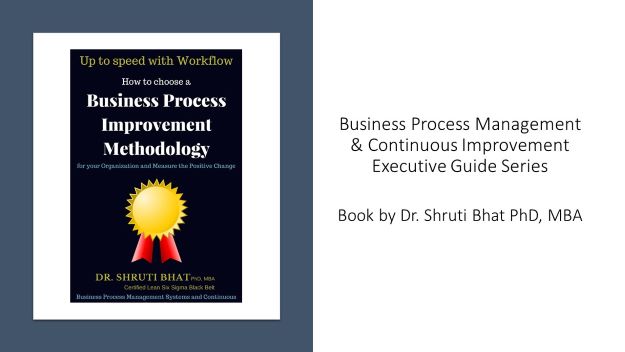Methods or processes, being the most critical out of the five, as, it alone (to a large extent) determines the consequences of the other 4Ms i.e. Man, Money, Machine and Materials. For examples, if the processes in a company were engaging, then employees would stay committed and contribute positively. ‘Machines’ would be productive, costs would go down and ‘Materials’ would be wisely used to generate profitable products, which in turn will help the business thrive, grow and make more money. Therefore, processes drive a chain reaction.
What will you learn from this book?
This book covers the following topics –
- Introduction to business process improvement lifecycle.
- How to strategically design process improvement initiatives to win campaigns.
- Roadmap to process improvement methodology selection including- base lining, change management, organizing business processes within an organization, identifying business process problem areas, various process improvement techniques and process improvement methodologies.
- Decision matrix for selecting process improvement methodology for your workplace.
- Action plan- for doing methodology implementation right!
- Qualifying ‘new’ business process and efficiency measurement metrics.
- Maintaining ‘continued’ operational excellence with the ‘new’ process.
- Illustrative examples of process improvement methodology recommendations for-
- Healthcare organization.
- Facility management and maintenance department of manufacturing organizations.
- IT department of non-profits, technology companies and manufacturing industries.
- Customer service departments of service organizations.
- Frequently asked questions and tips to maximize output from business process improvement campaigns.
Who should read this book?
This book is for Agile entrepreneurs and executives, involved in decision-making, directing their organization’s sustainability, profitability, expansion and who wish to apply business improvement methodologies to their work places in most beneficial, effective and practical ways.
Chapter 1:
Management of key business processes is of utmost importance to becoming a high performing organization, as they are the means to executing business strategies, by aligning process results with business goals.
Do the right thing for the customer and the customer will do the right thing for you. - Dr. Joseph Juran
As customer needs change frequently, one has to monitor them continuously and this is the fundamental basis for ‘Business process improvement’ and ‘Continuous improvement’. Those who learn this outperform their competitors because they have a much better understanding of their customers.
Business process improvement drives substantial bottom-line increases, customer satisfaction, ultimately accelerating the company’s revenue cycle. In today’s highly dynamic economies, the ones who do not get this mantra eventually have two choices- they get it or they go out.
However, the biggest problem faced by most companies worldwide, is not its competitors. Rather the biggest problems are self-inflicted, that is, created in-house by the management. So how does a company choose the right business process improvement methodology to implement at their organization?
This would depend on what problem prevails in the organization, that one is trying to solve and why. For example- is there a design issue? A process issue? A defect issue? A variation issue? Or a combination of them.
The success of process improvement directly depends on the process improvement methodology selected to bring on the positive change.
It is equally true that choosing a correct process improvement methodology is critical and extremely challenging. This in turn depends on the ‘Process improvement lifecycle’ comprising of following steps-
Step 1: Base lining.
Step 2: Identify critical ‘process improvement’ implementation success factors.
Step 3: Organize and centrally locate processes.
Step 4: Standardize processes spread across multiple functions and business units.
Step 5: Re-design ineffective or in-efficient processes.
Step 6: Eliminate work-around or duplicate steps.
Step 7: Automate processes wherever possible.
Step 8: Identify and apply metrics and KPI (key performance indicators).
Step 9: Cross-train employees.
‘Identification’ of process improvement methodology stems out of information gathered from steps 1 to 3, while the success of ‘methodology implementation’ is dependent on steps 4 to 9.
‘Business process improvement methodology selection’ involves two phases– ‘methodology identification’ and ‘methodology implementation’
This book highlights salient details about “How to choose a business process improvement methodology for your organization and measure the positive change”. Further, in the book we will dive into which methodologies might be appropriate for different industry verticals, different processes and different types of companies, as well as few important frequently asked questions.
Coming up in the next section- Potential success factors to winning process improvement campaigns…
**********
End of Preview
Grab your copy of this book Now!
|
About the Author: Shruti Bhat PhD, MBA, Lean Six Sigma Black Belt
Dr. Shruti Bhat is an award-winning Business Excellence Leader, Global Continuous Improvement Mastermind, Best-selling Author and Speaker. She is Continuous Improvement Advisor to several start-ups, mid-size and growing firms in Canada, USA, India, Africa and Emerging markets. She has authored eight business books and is an invited speaker at several national and international conferences, symposia and workshops.
Follow Shruti on Twitter, YouTube, LinkedIn
Keywords and Tags:
#DrShrutiBhat #Manufacturing #Lean #ProcessExcellence #ContinuousImprovement #Kaizen #QualityImprovement #Innovation #Quality #eLearning #Business #BusinessProcessManagement #ServiceIndustry #ManufacturingManagement #LeanInnovation #Pharmaceutical #LifeScience #Food #Beverage #Biotechnology #Retail #Cosmetics #PersonalProducts #Chemicals #Drugs #Engineering #ShiftingParadigms #BPM #LeanManagement #KaizenMasterclass #LeanSixSigma #Kanban #FMEA #RiskManagement #Speaker






















